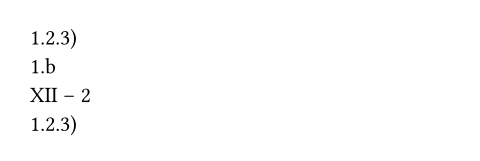このページはまだ翻訳されていません。原文の内容が表示されています。
numbering
Applies a numbering to a sequence of numbers.
A numbering defines how a sequence of numbers should be displayed as content. It is defined either through a pattern string or an arbitrary function.
A numbering pattern consists of counting symbols, for which the actual number is substituted, their prefixes, and one suffix. The prefixes and the suffix are repeated as-is.
Example
#numbering("1.1)", 1, 2, 3) \
#numbering("1.a.i", 1, 2) \
#numbering("I – 1", 12, 2) \
#numbering(
(..nums) => nums
.pos()
.map(str)
.join(".") + ")",
1, 2, 3,
)

Numbering patterns and numbering functions
There are multiple instances where you can provide a numbering pattern or
function in Typst. For example, when defining how to number
headings or figures. Every time, the expected format
is the same as the one described below for the
numbering parameter.
The following example illustrates that a numbering function is just a
regular function that accepts numbers and returns content.
#let unary(.., last) = "|" * last
#set heading(numbering: unary)
= First heading
= Second heading
= Third heading

引数引数引数は関数への入力値です。関数名の後に括弧で囲んで指定します。
numbering
Defines how the numbering works.
Counting symbols are 1, a, A, i, I, α, Α, 一, 壹,
あ, い, ア, イ, א, 가, ㄱ, *, ١, ۱, १, ১, ক,
①, and ⓵. They are replaced by the number in the sequence,
preserving the original case.
The * character means that symbols should be used to count, in the
order of *, †, ‡, §, ¶, ‖. If there are more than six
items, the number is represented using repeated symbols.
Suffixes are all characters after the last counting symbol. They are repeated as-is at the end of any rendered number.
Prefixes are all characters that are neither counting symbols nor suffixes. They are repeated as-is at in front of their rendered equivalent of their counting symbol.
This parameter can also be an arbitrary function that gets each number
as an individual argument. When given a function, the numbering
function just forwards the arguments to that function. While this is not
particularly useful in itself, it means that you can just give arbitrary
numberings to the numbering function without caring whether they are
defined as a pattern or function.
numbers必須引数必須引数必須引数は、関数を呼び出す際に必ず指定しなければなりません。位置引数位置引数位置引数は順序通りに指定することで、引数名を省略して設定できます。可変長引数可変長引数可変長引数は複数回指定することができます。
The numbers to apply the numbering to. Must be positive.
If numbering is a pattern and more numbers than counting symbols are
given, the last counting symbol with its prefix is repeated.